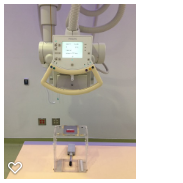Radiation Lab Simulator
Half Value Layer Lab
Half value layer (HVL) is defined as the thickness of a material which reduces beam intensity by exactly 50%. This concept is equally valid for monoenergetic (radionuclide) and polyenergentic (x-ray) beams.  It's measurement in the fields is straightforward. Simply take an output measurement with no filter in the beam, then add filters until the measured output is half its original value.
It's measurement in the fields is straightforward. Simply take an output measurement with no filter in the beam, then add filters until the measured output is half its original value.
X-ray beams contain a spectrum of energies. Because higher energy photons in an x-ray beam are more penetrating than low energy photons, . Even though an absorber in an x-ray beam will cause a decrease in intensity, because a larger fraction of low energy photons than of high energy photons are removed, the average beam energy will increase. This is known as beam hardening.
The amount of absorber required to reduce beam intensity from 100% (no filter) to 50% is called the first half value layer. The amount of absorber required to reduce beam intensity from 50% to 25% is called the second half value layer. First and second half value layers are equal for monoenergetic photon beams. But because of beam hardening, it will take more absorber to reduce an x-ray beam from 50% of its original (no filter) intensity to 25% than it takes to reduce the beam from 100% to 50%. Thus second half value layer will be larger than first half value layer.
Half value layer is a function of the x-ray beam spectrum which only changes with kilovoltage but not with mA or exposure time. This can be demonstrated in the lab below.
This lab simulation allows you to set up exposure factors, make a simulated exposure, and measure the output while placing external filters in the beam. There are two ways you may perform this lab.
-
Free selection of exposure factors and filters
OR
- Guided lab
- Make a set of exposures at a set x-ray technique (kVp, mA, and exposure time) starting with no filter in the beam. With no changes to x-ray technique make additional exposures with increasing filter thicknesses. Note the first half value layer thickness.
- Continue adding filters until the unfiltered exposure is reduced by a factor of 4. This is the second half value layer.
- Repeat the above experiment for different sets of exposures vaying either kVp, mA, or exposure time. Note how half value layer changes with each exposure parameter.
home
Associate Professor, Augusta University